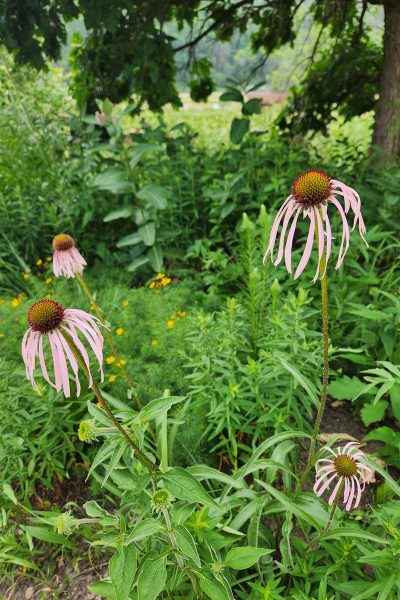
Everywhere, summer is in full swing. Including in the prairies – they are showing off their true colors! Bursts of purple, yellow, and orange have transformed June’s sea of green.
Here are a few of the species you’re sure to see while hiking in July! There are many more blooming around the state. What have you seen? (Add your finds in comment section!)

Compass Plant:
Silphium are a family of long-lived prairie plants with some of the largest leaves in the prairie. Some silphium species, like Compass Plant, have a flowering stalk that gets to be 5–to 8-feet tall, with their root system reaching 14 feet down into the ground. (Note Miranda as a measurement!)


Pale Purple Coneflower:
Echinacea pallida is a native species on the Wisconsin DNR’s list of threatened plants. Echinacea (genus name) comes from the Greek word echinos meaning “hedgehog” or “sea urchin” in reference to its spiny center flower cone. Pallida is Latin and translated means “pale.” The narrow leaves of the plant, along with its long, narrow, drooping petals, distinguishes it from its close relative and predominant species the “Purple Coneflower.”
Purple Prairie Clover:
Dalea purpurea boasts a thimble shaped flowers that sit atop a spray of stems with delicate foliage. Despite its name, it is not a true clover, but a legume with a long taproot. It offers a protein source for grazing herbivores, as well as a nectar source for many pollinators. Its flowering pattern is also unique: it flowers in bands around the seed head, starting from the bottom moving up.


Butterfly Milkweed:
Asclepias tuberosa, commonly known as butterfly weed, is a member of the milkweed family (Asclepiadaceae). The genus name Asclepias is named after the Greek god of medicine Asklepios. Butterfly weed is the flashiest of the 12 species of milkweed native to Wisconsin, but it is the only one that does not have “milky” sap.
Lance-leaved Coreopsis:
A member of the Asteraceae (Aster) family, Coreopsis lanceolata is a favorite of bees, birds, and butterflies. Coreopsis species are sometimes referred to as “tickseeds” due to the shape of the mature seed resembling a tick.


Hoary Vervain:
Verbena stricta prefers dry soils but has a close relative (Blue Vervain) that prefers wet meadows. An important source of nectar for pollinators, the beautiful lavender spires of Hoary Vervain make a distinctive statement in the late summer landscape.

